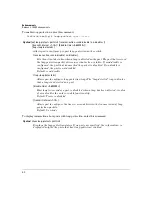
61
Enhancements
Release L.10.20 Enhancements
SNMPv3 User Commands
Listing Users.
To display the management stations configured to access the switch with SNMPv3
and view the authentication and privacy protocols that each station uses, enter the
show snmpv3 user
command.
Syntax:
show snmpv3 user
Configuring Loop Protection
You can use BPDU protection for systems that have spanning tree enabled (See
), however, the BPDU protection feature cannot detect the formation of loops
when an unmanaged device on the network drops spanning tree packets. To protect against the
formation of loops in these cases, you can enable the Loop Protection feature, which provides
protection by transmitting loop protocol packets out ports on which loop protection has been
enabled. When the switch sends out a loop protocol packet and then receives the same packet on a
port that has
send-disable
configured, it shuts down the port from which the packet was sent.
You can configure the
disable-timer
parameter for the amount of time you want the port to remain
disabled (0 to 604800 seconds). If you configure a value of zero, the port will not be re-enabled.
Syntax:
[no] snmpv3 user
<user_name>
Adds or deletes a user entry for SNMPv3. Authorization and
privacy are optional, but to use privacy, you must use
authorization. When you delete a user, only the
<user_name>
is
required.
[auth <md5 | sha>
<auth_pass>
]
With authorization, you can set either MD5 or SHA
authentication. The authentication password <auth_pass> must
be 6-32 characters in length and is mandatory when you
configure authentication. Default: None
[priv <des | aes>
<priv_pass>
]
With privacy, the switch supports DES (56-bit) and AES (128-
bit) encryption. The privacy password <priv_pass> must be 6-32
characters in length and is mandatory when you configure
privacy.
Default: DES
Note
:
Only AES 128-bit and DES 56-bit encryption are supported
as privacy protocols. Other non-standard encryption algorithms,
such as AES-172, AES-256, and 3-DES are not supported.
















































